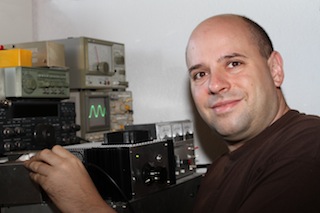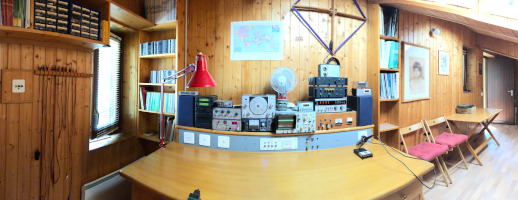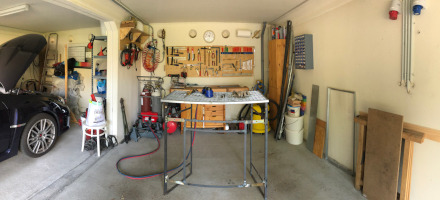www.giangrandi.ch is a
non-profit web site. It's just intended for sharing information and simple
design tools about subjects I care, like electronics, ham radio, antennas,
algorithms, photography, physics, mechanics and much more.
If you wonder why I built and I keep updating this website, there are several reasons: first because I think that technical information, knowledge and experience should be shared and should be free. There are a lot simple tricks and interesting circuits that may be very useful, but are so hard to find if written on a piece of paper or when printed in an old dusty book: information in a website is so much easier to find and is perfect for sharing. I hope you may find here something useful or interesting for you. But of course, I do it also for myself, so that I can keep track of some of the things I do.
The philosophy behind it is simple: a very light page layout, very simple graphics, no pop-ups, no advertising and no sponsors to make it easier for you to read. The pages are kept very simple with no useless animations, no flashing colors, no frames, no complicated menus and no plugins to install. The intention is to make this site easy to read, nice to surf and fast to load.
Some pages use JavaScript to implement simple calculators that can be handy
in (at least) some situations, I hope.
A nice feature of JavaScript is that it runs on any web browser without
installing any extra package and offers much more computing power than a
scientific calculator.
The source code is in the .html (or .shtml) page
itself, so that you can easily make a working local copy if you want: just
click File - Save as... (or something similar) in your browser
and you're good to go.
I started my personal pages back in 1997 and at that time it was just called "Jack's home page" as my friends used to call me Jack. To be honest, there was not much interesting stuff on those pages: I was just having fun with HTML. But I ended up liking the idea of sharing information. I registered the actual domain name in 2002 and for that occasion I redesigned the whole site with almost the same look and feel and philosophy that it still has now. But more importantly, I started publishing pages with deeper technical content; something that I would be interested in reading myself. I know that personal websites are a thing of the past, and this one is no exception. Still, I enjoy writing new pages when I have time.
Many of the early pages have been reworked, corrected, extended and updated during the years and there is little left untouched. The goal is to improve explanations, correct errors, correct typos, and provide bibliography references that were missing in the first articles.
I also wish to say a big thank you to my friend Cleto Pescia who kindly hosts this website since all these years and makes this possible.
My name is Iacopo Giangrandi and I always had a fascination with electronics: when I was 6 I built my first electric circuit: two light-bulbs and a battery. When I was 8 I got a soldering iron and my first transistor, and when I was 14 I finally got an oscilloscope... and I still have it. So I decided to study electronics and I ended up with a degree in electrical engineering of the Swiss Federal Institute of Technology of Lausanne (EPFL). Even if electronics is now my daily job and I have been doing it for several decades, I still enjoy it and I have a lot of fun in home-brewing any kind of circuit.

I also discovered the magic of the radio when I was very young. The idea of hearing or talking to the other side of the world with some simple home-built circuit and a piece of wire hanging down a tree still amazes me. Of course, I'm also a ham radio operator and my call-sign is HB9DUL, but I'm not very active on the air: I have much more fun in building a radio than in using it!
But electronics is not all: I also like mechanics, physics, chemistry and civil engineering, just to say a few of them. They are all fascinating domains and sometimes I like to share a bit of those on this website as well.
Some people ask me how my lab looks like, what equipment I have or what do they need to get started. So here I take you through a short guided tour of my labs.
I started setting up my first lab when I was 8 by laying a power supply, a multimeter, a soldering iron and some tools on the desk in my bedroom. Because the "electric stuff" was growing and I needed more space, two years later I was allowed to move to the attic where I could set up my first real lab. That lab is still in my parents' house almost untouched since the mid '90s, and I still enjoy repairing some broken appliance there when I visit them. You can see a picture here:

My first lab, as it looks in 2020, but it didn't change much in the
last 30 years. (click to enlarge)
In the middle is my first oscilloscope that I got for my birthday when I turned 14, accompanied by a nixie tube frequency counter, a vacuum tube radio-frequency generator and a lot of instruments I built myself when I was a teenager: a power supply, a signal tracer, a signal injector, a capacitance meter, a crystal tester, a function generator and many others. The diamond-shaped loop antenna on the wall was for listening to very long waves in the 30 to 150 kHz range that I built it from a reel of doorbell wire... The lightning flash counter sits on the right speaker since 1997.
Since then, I always had a lab in my house... it's like the kitchen: I cannot live without one. If you're curious, here are pictures of the three labs I currently have. First is my electronics lab that is combined with my ham radio station. Nothing spectacular: a couple of oscilloscopes (one digital and my trusty analog one), several power supplies (one never has enough of them), old radio-frequency and function generators, a frequency counter and a soldering iron... combined with a couple of transceivers, antenna tuners and SWR meters, that's enough for me to have fun. Here is where I build, fix and repair all my electronics circuits. If you look carefully in the middle of the picture, you will recognize the C-MOS clock with its green 7-segments display that I built in 1994 and has been running ever since.

My actual electronics lab and ham radio station as it looked like in
2020. (click to enlarge)
A lab is not a workshop: you cannot do mechanics in the same place you do electronics: metal shavings are not good for circuits. So I set up a small workshop in the basement with some basic tools: a sturdy workbench, a vise, a drill press, a sheet metal brake, a mini-lathe, a CNC router, a shop vac, a cyclone sawdust collector and a couple of bench grinders. It's a compromise for the space available, but more than enough for some fun with mechanics and woodworking. Of course, there is also a small compressor and the home-brew steam whistle on the wall...

My mechanical (and woodworking) workshop as it was in 2020.
(click to enlarge)
But one workshop is not enough... so I set up a second one in the garage for the "dirty" stuff: mainly grinding and welding that are not so suited to be done indoors. Everything is pretty tight in there, but the good news is that I can still park my car when I'm not welding. Of course, I wish I had one of those nice welding workbenches made of thick steel... but I don't have the space for that, so I use a ventilation grid from a light well on a folding stand. It's not as stable and not as flat, but it can be easily stored out of the way. And when you cut steel all the sparks go right through: it works quite well.

My welding workshop in the garage as it was in 2020. (click to enlarge)
There are a few questions I get quite often (or that I don't want anymore): here are the most common (and their answers):
If you want to send me your comments feel free to write me at the following address, I appreciate your feedback:
| Home | Back | Page hits: 029609 | Created: 03.2005 | Last update: 02.2024 |